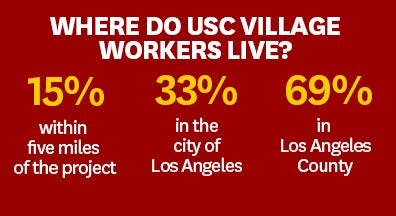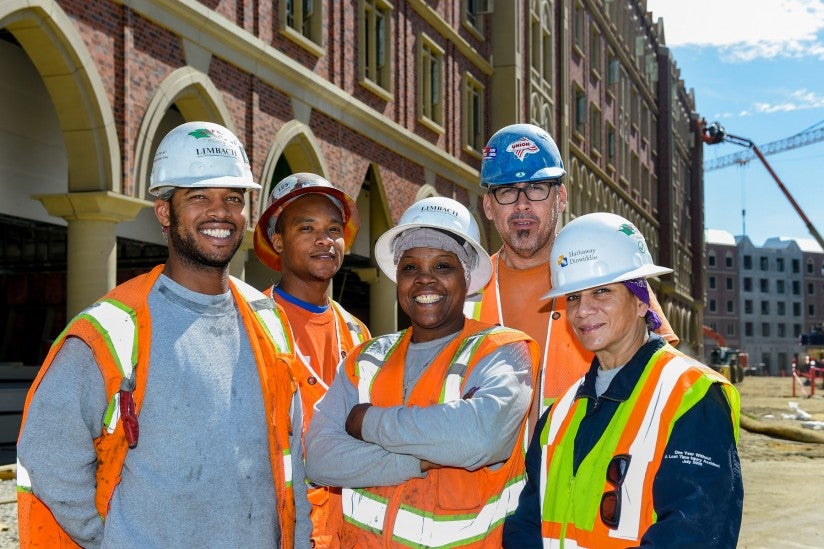Local residents find work — and the path to a career — at USC Village
Construction crews have worked more than 1 million combined hours on the massive development
Sheila Cooper had only worked three months in the past three years when the five digits of her ZIP code unexpectedly became her lucky numbers.
Those living within five miles of USC were moved to the front of the line as part of the local hiring initiative at the USC Village construction project. That meant Cooper, a pipe fitter who lives four miles away, would be getting some much-needed work.

“We went through a rough time,” Cooper said. “But I see things turning around.”
Cooper is just one of the hundreds of local residents who have gotten a job on one of the largest construction projects in the history of South Los Angeles.
“USC Village is putting many people on the path to lifelong careers,” said Thomas S. Sayles, senior vice president of University Relations. “This is a path to the middle class. And this is an impact on multiple generations.”
An ambitious effort
Men and women from all over Los Angeles are building USC Village, the most ambitious construction effort in university history.
So far more than 3,200 people have worked more than 1 million combined hours on the $700 million privately funded development.
And we’re only at the halfway point in the creation of the massive 1.2 million-square-foot, mixed-use development that sits on 15 acres just north of campus on Jefferson Boulevard.
To date, construction workers have:
- Poured 90,000 cubic yards of concrete — enough to build a sidewalk from Los Angeles to San Francisco.
- Laid 23 million pounds of rebar to form the walls and foundation of the construction of the Village’s five buildings.
- Installed 2,500 exterior panels.
- Hoisted the 12,700-pound roof spire eight stories to top the McCarthy Honors College.
Job fairs
Cooper first heard of the possibility of working in her neighborhood through a job fair hosted by USC — just part of the university’s outreach to local residents since the project’s approval four years ago.
Hundreds of people have attended eight recruitment events that USC has sponsored with local partner organizations like Los Angeles Trade Tech, the Los Angeles Unified School District, LA Reentry, YouthBuild, Helmets to Hard Hats, 2nd Call and the Empowerment Congress in an effort to find, hire and train candidates.
Another outreach partner, the South LA Worksource Center, conducts orientations on the first and third Thursday of every month for locals.
The federally funded organization does more than recruit — it helps workers navigate hurdles to employment, such as the $100 steel-toed boots, funds to get OSHA training, Hazmat certification or the other requirements needed to be on a construction site.
“The goal is to equip people with the skills for a lifetime,” said Henryetta Andrade, director of South LA Worksource.
When USC Village opens in fall 2017 with a Target, a Trader Joe’s and 2,700 student beds, it is sure to be the center of life at USC and of the University Park neighborhood.
Short commute
For Dianne Bryant, who lives in the Crenshaw District, the shorter commute to USC was also something to get excited about. Last year she moved near San Bernardino to work on the $300 million I-15 interchange project.

“USC Village is the closest long-term job I’ve had in my 12 years,” said Bryant, who followed a long line of women in her family to work in construction. “This is so rare, long-term and local. It’s a blessing.”
Bryant is a heavy equipment operator at USC Village who not too long ago helped build the Expo Line light rail.
The importance of working on such monumental projects that change the skyline of a city or the character of neighborhood is not lost on those responsible for building Los Angeles.
“Sometimes I drive around and show my daughter the projects I’ve worked on,” said Robert Gandara of Eagle Rock, who puts up drywall and metal framing at USC Village. “I tell her, ‘Daddy built that.’ When I got in the trade, I couldn’t read a tape measure. I tell her, ‘See, with hard work, you can accomplish great things.’ ”
